The Belt Feeders Market is estimated to be valued at USD 1.2 billion in 2025 and is projected to reach USD 1.9 billion by 2035, registering a compound annual growth rate (CAGR) of 5.1% over the forecast period.
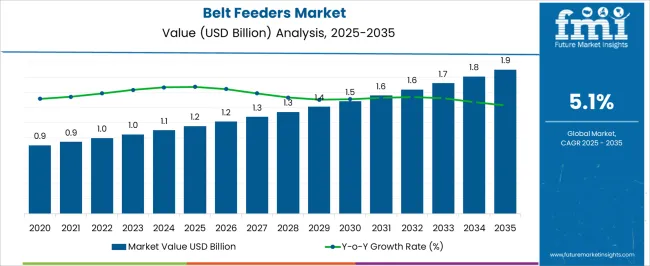
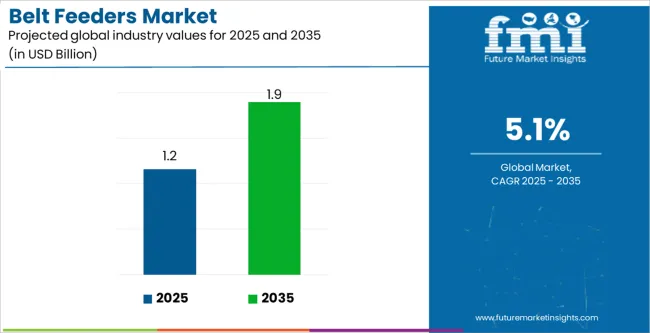
| Metric | Value |
|---|---|
| Belt Feeders Market Estimated Value in (2025 E) | USD 1.2 billion |
| Belt Feeders Market Forecast Value in (2035 F) | USD 1.9 billion |
| Forecast CAGR (2025 to 2035) | 5.1% |
The Belt Feeders market is experiencing steady growth driven by increasing automation and mechanization in material handling across mining, metallurgy, and chemical industries. The market is being shaped by rising demand for continuous and controlled feeding of bulk materials in processing plants, where efficiency and operational reliability are critical.
Growth is supported by the ongoing need for high-capacity material handling systems capable of operating under harsh conditions while reducing labor intensity and downtime. Technological advancements in belt feeder design, including energy-efficient drives, precise feed rate control, and integration with smart monitoring systems, are facilitating improved productivity and operational safety.
Rising investments in mining and industrial infrastructure, along with the adoption of Industry 4.0 practices, are driving the integration of automated belt feeders into broader process control systems As industries continue to optimize material flow management and focus on cost reduction, the Belt Feeders market is anticipated to witness sustained expansion, offering opportunities for innovative, software-enabled, and maintenance-friendly feeding solutions.
The belt feeders market is segmented by product type, application, and geographic regions. By product type, belt feeders market is divided into Flat Belt and Groove Type Belt. In terms of application, belt feeders market is classified into Mining Industry, Metallurgy Industry, Chemical Industry, Casting Industry, Construction Industry, and Others. Regionally, the belt feeders industry is classified into North America, Latin America, Western Europe, Eastern Europe, Balkan & Baltic Countries, Russia & Belarus, Central Asia, East Asia, South Asia & Pacific, and the Middle East & Africa.
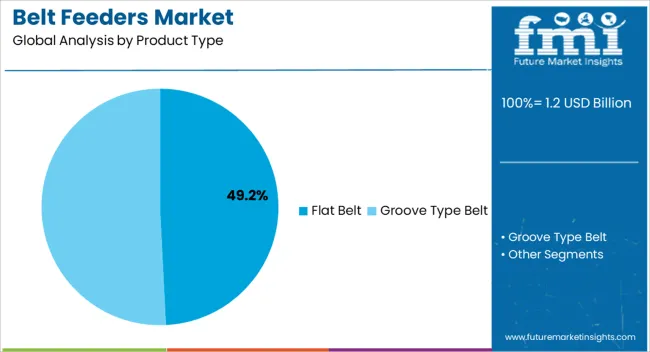
The Flat Belt product type is projected to hold 49.20% of the Belt Feeders market revenue share in 2025, making it the leading product type. This dominance is being attributed to the simplicity and reliability of flat belt systems, which allow for consistent and controlled material transport over variable distances and inclines.
Adoption has been driven by the need for cost-effective solutions that can be easily maintained and integrated into existing conveyor infrastructure. Flat belts are preferred in heavy-duty industrial applications because they provide uniform tension distribution, reduce material spillage, and support higher throughput rates compared to alternative belt types.
Additionally, the adaptability of flat belt feeders for a wide range of material sizes and weights has reinforced their preference in industries requiring precise feed control The segment’s growth is being further supported by increasing mechanization in mining and processing operations, where operators prioritize efficiency, durability, and low operational complexity.
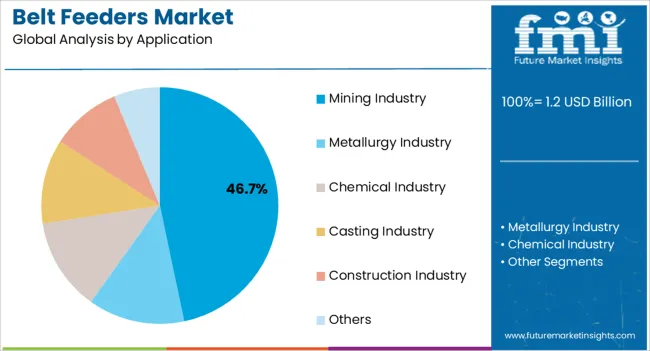
The Mining Industry application segment is anticipated to account for 46.70% of the Belt Feeders market revenue in 2025, establishing it as the leading application area. This growth is being driven by the high demand for continuous, controlled feeding of bulk materials in mining operations, where throughput optimization and process stability are critical.
Belt feeders are extensively deployed in mineral processing, coal handling, and ore extraction to ensure consistent feed rates to crushers, conveyors, and screening equipment. The segment has benefited from investments in automation and the integration of monitoring systems that allow real-time control of feed volumes, improving operational efficiency and safety.
The ability to operate reliably in harsh environments, handle abrasive and heavy materials, and reduce labor dependency has further reinforced adoption Increasing global mining activity and the need to meet rising demand for metals, minerals, and energy resources are expected to sustain growth in this segment, making it the primary driver of the Belt Feeders market.
Belt feeders are used in numerous industries including construction, food processing, mining, agricultural, quarrying, etc. Among these industries, mining has significant demand for belt feeders in a gamut of operating processes and site of installations.
Bulk material weighing, continuous material flow control, auto centering, belt speed measurement, belt speed frequency control, alarm signalling for failures, etc. are several functions perform by belt feeders.
The belt feeder is one of the type of feeder which is mostly used to provide a well-ordered bulk materials volumetric flow from the storage units.
These belts feeders are generally not recommended for tough bulk materials and very hard and only preferable for handling granular materials.
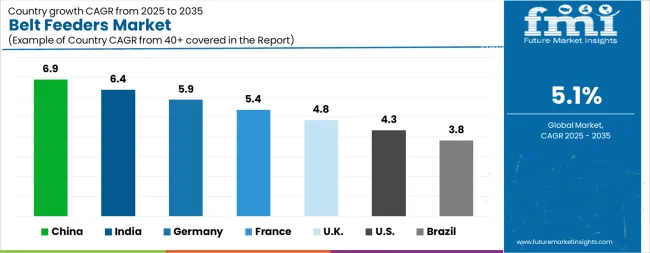
| Country | CAGR |
|---|---|
| China | 6.9% |
| India | 6.4% |
| Germany | 5.9% |
| France | 5.4% |
| UK | 4.8% |
| USA | 4.3% |
| Brazil | 3.8% |
The Belt Feeders Market is expected to register a CAGR of 5.1% during the forecast period, exhibiting varied country level momentum. China leads with the highest CAGR of 6.9%, followed by India at 6.4%. Developed markets such as Germany, France, and the UK continue to expand steadily, while the USA is likely to grow at consistent rates. Brazil posts the lowest CAGR at 3.8%, yet still underscores a broadly positive trajectory for the global Belt Feeders Market. In 2024, Germany held a dominant revenue in the Western Europe market and is expected to grow with a CAGR of 5.9%. The USA Belt Feeders Market is estimated to be valued at USD 426.0 million in 2025 and is anticipated to reach a valuation of USD 651.2 million by 2035. Sales are projected to rise at a CAGR of 4.3% over the forecast period between 2025 and 2035. While Japan and South Korea markets are estimated to be valued at USD 52.1 million and USD 36.4 million respectively in 2025.
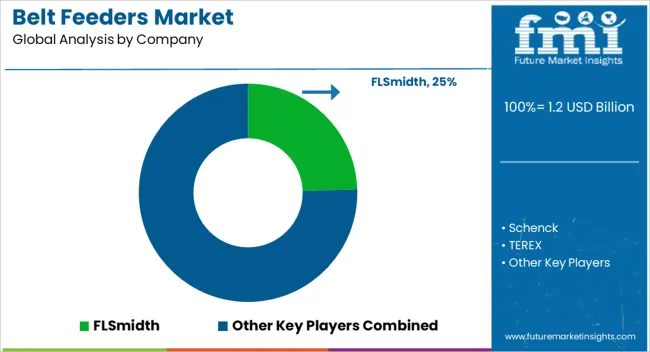
| Item | Value |
|---|---|
| Quantitative Units | USD 1.2 Billion |
| Product Type | Flat Belt and Groove Type Belt |
| Application | Mining Industry, Metallurgy Industry, Chemical Industry, Casting Industry, Construction Industry, and Others |
| Regions Covered | North America, Europe, Asia-Pacific, Latin America, Middle East & Africa |
| Country Covered | United States, Canada, Germany, France, United Kingdom, China, Japan, India, Brazil, South Africa |
| Key Companies Profiled | FLSmidth, Schenck, TEREX, Putzmeister, Metso, KOMATSU, HASLER, Sandvik, MERRICK Industries, Nordberg, Interroll, KELLVE, NORTHERN HEAVY INDUSTRIES, Hengyang Conveying Machinery, Jianye Heavy Industry, SAIMO, HONGXING MACHINERY, Norbans Automate, CZXINLI, and Haihui Group |
The global belt feeders market is estimated to be valued at USD 1.2 billion in 2025.
The market size for the belt feeders market is projected to reach USD 1.9 billion by 2035.
The belt feeders market is expected to grow at a 5.1% CAGR between 2025 and 2035.
The key product types in belt feeders market are flat belt and groove type belt.
In terms of application, mining industry segment to command 46.7% share in the belt feeders market in 2025.






Our Research Products

The "Full Research Suite" delivers actionable market intel, deep dives on markets or technologies, so clients act faster, cut risk, and unlock growth.

The Leaderboard benchmarks and ranks top vendors, classifying them as Established Leaders, Leading Challengers, or Disruptors & Challengers.

Locates where complements amplify value and substitutes erode it, forecasting net impact by horizon

We deliver granular, decision-grade intel: market sizing, 5-year forecasts, pricing, adoption, usage, revenue, and operational KPIs—plus competitor tracking, regulation, and value chains—across 60 countries broadly.

Spot the shifts before they hit your P&L. We track inflection points, adoption curves, pricing moves, and ecosystem plays to show where demand is heading, why it is changing, and what to do next across high-growth markets and disruptive tech

Real-time reads of user behavior. We track shifting priorities, perceptions of today’s and next-gen services, and provider experience, then pace how fast tech moves from trial to adoption, blending buyer, consumer, and channel inputs with social signals (#WhySwitch, #UX).

Partner with our analyst team to build a custom report designed around your business priorities. From analysing market trends to assessing competitors or crafting bespoke datasets, we tailor insights to your needs.
Supplier Intelligence
Discovery & Profiling
Capacity & Footprint
Performance & Risk
Compliance & Governance
Commercial Readiness
Who Supplies Whom
Scorecards & Shortlists
Playbooks & Docs
Category Intelligence
Definition & Scope
Demand & Use Cases
Cost Drivers
Market Structure
Supply Chain Map
Trade & Policy
Operating Norms
Deliverables
Buyer Intelligence
Account Basics
Spend & Scope
Procurement Model
Vendor Requirements
Terms & Policies
Entry Strategy
Pain Points & Triggers
Outputs
Pricing Analysis
Benchmarks
Trends
Should-Cost
Indexation
Landed Cost
Commercial Terms
Deliverables
Brand Analysis
Positioning & Value Prop
Share & Presence
Customer Evidence
Go-to-Market
Digital & Reputation
Compliance & Trust
KPIs & Gaps
Outputs
Full Research Suite comprises of:
Market outlook & trends analysis
Interviews & case studies
Strategic recommendations
Vendor profiles & capabilities analysis
5-year forecasts
8 regions and 60+ country-level data splits
Market segment data splits
12 months of continuous data updates
DELIVERED AS:
PDF EXCEL ONLINE
Belt Trainers Market Size and Share Forecast Outlook 2025 to 2035
Belt File Sander Market Size and Share Forecast Outlook 2025 to 2035
Seatbelt Polyester Yarn Market Size and Share Forecast Outlook 2025 to 2035
Pump Feeders Market Growth - Trends & Forecast 2025 to 2035
Cross-Belt Sorters Market
Chamber Belt Vacuum Machine Market Analysis Size and Share Forecast Outlook 2025 to 2035
Packing Belt Market Insights - Growth & Forecast 2025 to 2035
Modular Belt Drive Market
Conveyor Belt Tracking Devices Market Size and Share Forecast Outlook 2025 to 2035
Conveyor Belt Market Size and Share Forecast Outlook 2025 to 2035
Conveyor Belt Materials Market
Standard V Belts Market Size and Share Forecast Outlook 2025 to 2035
Brush-Type Belt Cleaners Market Size and Share Forecast Outlook 2025 to 2035
Blade-type Belt Cleaners Market Size and Share Forecast Outlook 2025 to 2035
Ammunition Belt Market Size and Share Forecast Outlook 2025 to 2035
Automotive Belts Market Growth - Trends & Forecast 2025 to 2035
Horse Grain Feeders Market Size and Share Forecast Outlook 2025 to 2035
Industrial V Belts Market Growth - Trends & Forecast 2025 to 2035
Conveyors and Belt Loaders Market Growth - Trends & Forecast 2025 to 2035
Automotive Seat Belts Market Size and Share Forecast Outlook 2025 to 2035

Thank you!
You will receive an email from our Business Development Manager. Please be sure to check your SPAM/JUNK folder too.
Chat With
MaRIA